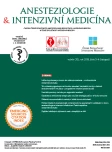Basic neuromodulation methods in chronic pain management
Authors:
J. Kozák 1; Š. Kozák 2; I. Vrba 3
Authors‘ workplace:
Centrum pro léčení a výzkum bolestivých stavů při Klinice rehabilitace a tělovýchovného lékařství, 2. lékařská fakulta Univerzity Karlovy a Fakultní nemocnice v Motole
1; Ambulance léčby bolesti, Klinika anesteziologie a resuscitace, 3. lékařská fakulta Univerzity Karlovy a Fakultní nemocnice Královské Vinohrady
2; Anesteziologicko-resuscitační oddělení, Nemocnice Na Homolce
3
Published in:
Anest. intenziv. Med., 30, 2019, č. 3-4, s. 153-161
Category:
Overview
Chronic pain is not always manageable with standard treatment modalities. Moreover, physicians are now globally on the constant lookout for opioid sparing in chronic pain management due to the „opioid crisis“, and neuromodulation treatment may by the possible answer. Neuromodulation is the process of inhibition, stimulation, modification or therapeutic alteration of activity in the central or peripheral nerve systems, with the use of electric current or drugs. The most important parts of neuromodulation for pain management are neurostimulation and intrathecal drug delivery. The use of neuromodulation has evidently seen growth over the course of the last decade due to novel systems, hardware advancements, and novel chronic pain indications. In this article we present an updated review on spinal cord stimulation and intrathecal drug delivery systems, and their use in chronic pain treatment.
Keywords:
chronic pain – neuromodulation – spinal cord stimulation – intrathecal drug delivery
Sources
1. Deer TR, Jain S, Hunter C, Chkravarthy K. Neurostimulation for intractable chronic pain. Brain Sci. 2019;9:art. 23.
2. Kozák J, Vrba I, Masopust V, et al. Neuromodulace v léčbě chronické bolesti. In: Bolest. Kršiak M, Kozák J, Rokyta R, eds. Praha: Tigis, 2012:595–621.
3. Vrba I, Chrobok J, Štětkářová. Typy bolesti a jejich léčba: Failed back surgery syndrome. In: Rokyta R, Kršiak M, Kozák J. Bolest: Monografie algeziologie. 2. vyd. Praha: Tigis, 2012:299–306.
4. Deer TR, Hayek SM, Pope JE, et al. The Polyanalgesic Consensus Conference (PACC): Recommendations for Trialing of Intrathecal Drug Delivery Infusion Therapy. Neuromodulation. 2017;20:133–154.
5. Gharibo Ch, Laux G, Forzani BR, et al. State of the field survey: Spinal cord stimulator use by academic pain medicine practices. Pain Med. 2014;15:188–195.
6. Russo M, Van-Buyten JP. 10-kHz-frequency SCS therapy: A clinical summary. Pain Med. 2015;16:934–942.
7. Chakravarthy K, Richter H, Christo PJ, et al. Spinal cord stimulation for treating chronic pain: Rewiewing preclinical and clinical data on paresthesia-free high frequency therapy. euromodulation. 2018;21:18–10.
8. Trentman TR, Zimmerman RS, Dodick DW. Occipital nerve stimulation: technical and surgical aspects of implantation. In: Peripheral Nerve Stimulation. Slavin KV, ed. Chicago, III: Karger, 2011:96–108.
9. Vrba I, Kozák J. Neurostimulace v léčbě ischemických bolestí typu anginy pectoris. In: Houdek M, a kol. Neuromodulace. Praha: Grada Publishing, 2007:131–142.
10. Osenbach RK, Haines SJ. Spinal cord stimululation for the treatment of refractory angina pectoris. Crit Rev Neurosurg. 2000;9:394–406.
11. Kapural L, Sessler D, Tluczek H, Nagem H. Spinal Cord Stimulation for visceral abdominal pain. Pain Med. 2010;11:347–355.
12. Derbyshire SW. Imaging visceral pain. Curr Pain Headache Rep. 2007;11:178–182.
13. Andres JD, Perotti L, Villaneuva-Perez V, Sensio-Samper JM, Fabregat-Cid G. Role of lumbosacral retrograde neuromodulation in the treatment of painful disorders. Pain Phys. 2013;16:145–153.
14. Ševčík P. Implantabilní infuzní pumpy. Houdek M, a kol. Neuromodulace. Praha: Grada Publishing, 2007:229–232.
15. Bolash R, Mekhail N. Intrathecal Pain Pumps – Indications, Patient Selection, Techniques, and Outcomes. Neurosurg Clin N Am. 2014;25:735–742.
16. Vrba I, Kozák J. Failed back surgery syndrome a neuromodulační léčba. Bolest. 2005;8:144–151.
17. Deer TR, Prager J, Lev R, et al. Polyanalgesic Consensus Conference - 2012: Recommendations to reduce morbidity and mortality in intrathecal drug delivery in the treatment of chronic pain. Neuromodulation. 2012;5:467–482b.
18. Adler JA, Lotz NM. Intrathecal pain management: a team-based approach. J Pain Res. 2017:10:2565–2575.
19. Deer TR, Pope JE, Hayek SM, et al. The Polyanalgesic Consensus Conference (PACC): Recommendations on intrathecal drug infusion systems best practices and guidelines. Neuromodulation. 2017;20:96–132.
20. Wunkelmüller W, Burchiel K, Van Buyten JP. Intrathecal opioid therapy for pain: Efficacy and outcomes. Neuromodulation. 1999;2:67–76.
21. Erdine S, De Andrés J. Drug delivery systems. Pain Pract. 2006;6:1–7.
22. Aló KM. Continuus intrathecal drug administartion trial method for complex benign pain: failed back surgery syndrome. J Pain Symptom Manag. 2000;20:41–50.
23. Dario A, Scamoni C, Picano M, et al. The infection risk of intrathecal drug infusion pumps after multiple refill procedures. Neuromodulation. 2005;8:36–39.
Labels
Anaesthesiology, Resuscitation and Inten Intensive Care MedicineArticle was published in
Anaesthesiology and Intensive Care Medicine

2019 Issue 3-4
Most read in this issue
- Kapilární návrat – klinické vyšetření přítomnosti cirkulační koherence?
- Basic neuromodulation methods in chronic pain management
- De-escalation of antibiotic therapy as a part of care strategy about critically ill patients
- Zajištění obtížných dýchacích cest u dospělých a dětí
